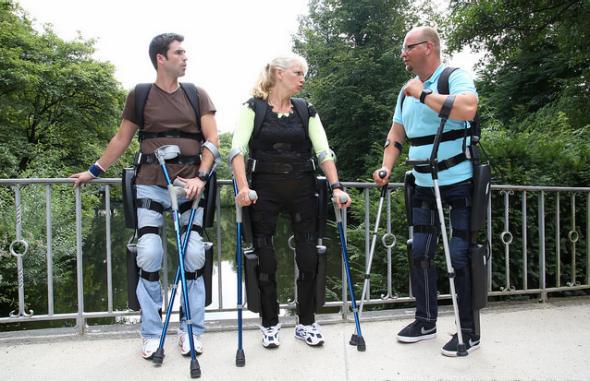In May, a bionic arm for amputees, controlled by signals from the brain, was allowed on the market. In June, a robotic suit helped a paraplegic man take the first kick at the 2014 World Cup. And just last week, Argo Medical Technologies’ ReWalk became the first exoskeleton for the disabled to be approved by the United States Food and Drug Administration. But those who should be benefitting from the exploding industry of disability technologies are beset with an inevitable but rather prosaic concern: how to pay for it.
The work of Dr. Amit Goffer, a quadriplegic himself, ReWalk uses a fitted brace with a computer-based control system backpack to simulate the gait of walking legs for those with spinal cord injuries that have left them paralyzed from the waist down. Battery-powered motors create joint movement, a wireless remote control worn on the wrist allows the user to command the suit’s motions, and a tilt sensor feels when the body is leaning forward and takes the first step. Crutches are also used for stability.
Systems like ReWalk and other players in this field, such as Ekso Bionics, are part of a burgeoning technology sector that will benefit the estimated 200,000 people in the United States living with a spinal cord injury and an estimated 1.7 million wheelchair users. But the relationship between disability and technology is a complicated one.
For one thing, the devices are often prohibitively expensive—the ReWalk alone costs almost $70,000. It’s taking time for bureaucracies, and most importantly, funding agencies to catch up with this eruption of highly innovative disability technology, Curtis Decker, executive director of the National Disability Rights Network told me. “It’s a challenge to getting a funding source for these devices, whether government or insurance coverage,” he said.
Take Medicaid. “It will be easier if there is a ready category of device that we could squeeze this into, but if not, it could take years,” Decker said. If there’s something very new and innovative and there’s no easy category, then you have to go through an extensive rule-making process with Medicaid. “My guess is that the exoskeleton is not something that would fit easily into an existing category.”
This seems especially likely given the FDA put ReWalk through its de novo classification process, what it calls “a regulatory pathway for novel, first-of-its-kind medical devices that are generally low-to moderate-risk,” because there’s really no technological predicate device on the market.
Medicaid is also an entitlement system primarily targeted at poorer people, Decker pointed out, so even if ReWalk is approved, it may be hard for people with some resources, or who are still working, to get their hands on the exoskeleton. “Private insurance is probably the least friendly to these types of things,” he said, “it’s easy to fall into a gap.”
Decker told me that there are innovative funding models—loan programs, for instance—but given the rapid obsolescence of these technologies, there’s a danger in investing in things that deteriorate or are out-innovated while you’re stuck paying them off.
Larry Jasinski, CEO of ReWalk, told Mashable that the company is working with insurers to allow eligible individuals the means of purchasing the system. And it’s not all bad news: “I’m hopeful that as these technologies come online, they do become more efficient and less expensive, like televisions and smartphones,” Decker added.
For now, those volunteering themselves to test out these technologies are stuck raising money for their own care.
Robert Woo, who was involved in the clinical testing of both ReWalk and Ekso Bionic’s exoskeleton, told CBS News that he’s making plans to finance the device, including, “selling some stock and investments, asking family members for help and contacting his health insurance provider and the medical team that ran the clinical trial.”
Or take Ian Burkhart, a young man from Ohio who was paralyzed after a diving accident, and who is working with researchers from Battelle and Ohio State on a project called Neurobridge. The project is cutting edge: Electrodes have been implanted into Burkhart’s frontal cortex to simulate a spinal cord and send signals from his brain to stir the muscles in his arms.
But Burkhart also had to raise money to help with his medical expenses—including a wheelchair. Which brings up another point about priorities and responsible innovation. Even as technologies like ReWalk gain momentum and research dollars flow to these ventures, the humble wheelchair still has major problems. For instance, two of Decker’s colleagues in wheelchairs have problems with simple, everyday rain—if their joysticks get wet, it can be disastrous.
